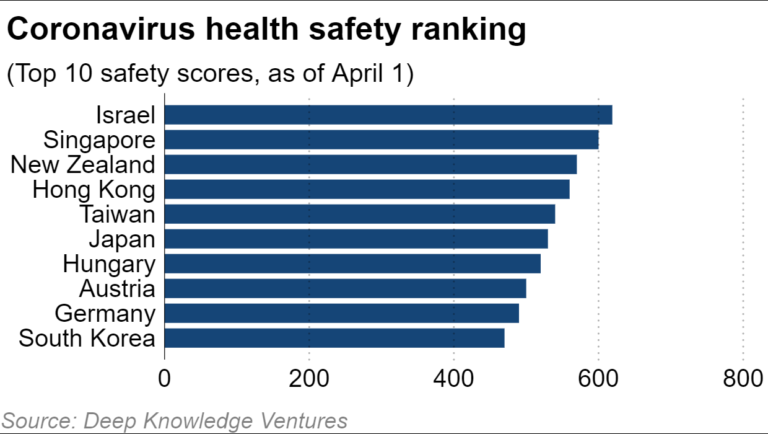Why Panic is the Worst Response to an Infectious Epidemic
Professor Philip Alcades, the author of the book, Dread: How Fear and Fantasy Have Fueled Epidemics from the Black Death to Avian Flu, provides a calm assessment of the current state of confusion about the Coronavirus within a historical framework.
“For 40 years, many public health professionals and a number of journalists and writers have made their careers by predicting that there will one day be a reprise of the deadly flu pandemic of 1918-19…”
Also posted below is a letter to the Editor of the BMJ [British Medical Journal]
Why Novel Coronavirus Fatality is Likely Overestimated.
The letter is authored by three Emergency Medicine physicians from the Yale School of Medicine, Harvard Medical School and Johns Hopkins Hospital
COVID-19: A Primer: How to think about the coronavirus
By Philip Alcabes The AMERICAN SCHOLAR, March 10, 2020Every epidemic is theater, a drama written by the powerful for the sake of the unsuspecting. AIDS became a morality tale of innocence and sin. Outbreaks of Ebola became stories of strange tribal customs and feckless governments. Measles outbreaks become the fault of a delusional but highly organized “anti-vaxxer” movement. What’s unusual about the outbreak of COVID-19 is that the story isn’t being told by the powerful. The powerful are just consumers here, responders, sometimes influencers, salespeople of a certain frightened view. But the story of COVID-19—a surrealist masterpiece—masked citizens, ubiquitous squeeze bottles of Purell, conspiracy theories, bravado, insouciance, boredom, and anxiety—is taking shape purely out of information.
A little epidemiology to start with. It’s becoming clearer by the day that COVID-19 is a conventional virus. By this I mean that many people who are infected (perhaps most) do not get sick at all or become only mildly ill. Most of those who do get sick are older (children under age 15 are almost never reported among the seriously ill). They may have a concerning but not serious illness, including fever and cough. A few suffer badly. Some must be hospitalized, and a fraction of those who are hospitalized have and will continue to die.
…
the Return-of-the-Spanish-Flu industry. For 40 years, many public health professionals and a number of journalists and writers have made their careers by predicting that there will one day be a reprise of the deadly flu pandemic of 1918-19. That outbreak involved an unusual strain of influenza and a world exhausted by war. It led to 50 or 100 million deaths worldwide. There is no reason to believe that the set of circumstances that allowed that event to be so deadly will recur. But you will hear and read, asserted as fact, that it will. Federal health officials say it whenever the subject of flu vaccine comes up. Predicting the return of the 1918 flu is a profitable business that seems never to wear out. People must be forgiven for thinking, constantly, that some new pandemic is going to wreak havoc in the old way.
The most curious aspect of the COVID-19 drama is its transformation of authoritarian, or wannabe-authoritarian, regimes into fickle blitherers. In the past, the Trump administration in the US, Putin in Russia, the Xi administration in China, and their many imitators had been decisive and ruthless in locking up their undesirables and in delivering policies that appeal to hypernationalist rhetoric. But none of them has been able to institute a sensible policy on coronavirus—a policy with clearly articulated aims, with criteria for the determination of when the policy can end. Plus, the policies change every day.
There will be testing, there will be enforced quarantines, there will be suggested self-quarantine, there won’t be testing because the test kits aren’t ready, there should be a vaccine soon, there won’t be a vaccine soon, stock up on a month’s supply of food and medicine (do that many people live in apartments big enough to accommodate a month’s supply of food?). Chinese officials are building blue walls within cities. Trump, the wall man, says his wall will stop the virus until it’s pointed out that there isn’t a wall, and then he blames Obama. The U.S. Centers for Disease Control and Prevention recommends more testing but rejects an effective test for the virus adopted by WHO, then announces it will take more time for a U.S. test to be ready. People must be forgiven for not trusting governments to protect them.
What should governments be doing?
Stop issuing warnings, start protecting people who are older and have health conditions. Closing schools is rarely the right thing to do: children are not susceptible to serious illness from this virus. The more that COVID-19 spreads among those who don’t get sick from it, i.e., children, the faster it will evolve into a less pathogenic form.
Philip Alcabes, PhD is a professor of public health at Hunter College of the City University of New York. He received his doctorate in Epidemiology from the Johns Hopkins University, School of Hygiene and Public Health.
Why Novel Coronavirus Fatality is Likely Overestimated, BMJ Rapid Response. March 4, 2020
The authors of this letter to the BMJ Editor:
Joshua D. Niforatos (Emergency Medicine), Edward R. Melnick, MD, MHS, Yale School of Medicine, and Jeremy S. Faust MD, Brigham and Women’s Hospital, Emergency Medicine, Harvard Medical ShoolDear Editor,
While the case fatality rate (CFR) of 2019-nCoV, the virus that causes COVID19, remains unknown, recently published figures likely overestimate the true rate.(1) Previous reviews of H1N1, MERS, and SARS highlight the difficulty of early estimation of CFR of novel viruses related to an absence of consensus on defining and measuring incidences and severities of infection.(2,3) Early estimates of H1N1’s CFR were susceptible to uncertainty regarding asymptomatic and subclinical infections, heterogeneity in approaches to diagnostic testing, as well as biases in ascertainment, survivorship, confounding and selection, and reporting.(2,3) These biases are difficult to overcome early in a pandemic.(3)
In this regard, we read Xu et al’s report of 62 cases of COVID-19 outside of Wuhan, China with great interest since no patients died throughout the study period.(4) In comparison with Wu and McGoogan’s (5) report of the 72,314 cases of COVID-19 throughout China, the marked differences in outcomes among cases from Hubei compared to those from all other Provinces (5) provide insight into the severity of this disease.
The CFR amongst all confirmed cases in China (through February 11) is reported as 2.3%.(1,5) The CFR among the initial Wuhan cohort was reported as 4.3%, and 2.9% in Hubei.(1,5) However, in subsequent cases outside of Hubei, the CFR has been 0.4%. Deaths occurred only in cases deemed “critical.” No deaths were observed among asymptomatic carriers, nor in patients with mild or even severe presentations of confirmed disease. Importantly, the CFR from these reports are from infected, syndromic persons presenting to health care facilities, with higher CFRs among older, hospitalized patients (8% – 14.8% in the Wuhan cohort).
Given the non-specific symptoms of patients with confirmed COVID-19,(6) and the absence of deaths among asymptomatic, mild, and severe cases,(1,6) many if not most cases of 2019-nCoV likely remain unaccounted for in the denominator of current CFR estimates. Additionally, the number of patients who die from the virus as opposed to with the virus is unknown.
There are increasing reports of confirmed COVID-19 cases in individuals without travel history or risk factors for transmission in the U.S, representing community spread among asymptomatic carriers and undiagnosed mild cases. Though systemic testing capacity for 2019-nCoV is increasing, forthcoming weekly reports of CFR are unlikely to capture asymptomatic and mild cases that never present to health care facilities, especially since milder and asymptomatic cases will be identified at a slower pace than severe and critical cases.(7)
As with other epidemics, the final CFR for COVID-19 will likely be significantly lower than both the currently reported rates, and those announced in the coming weeks. Accurate CFRs are only possible after the rates of asymptomatic infection and mild otherwise unreported cases are determined.
References
1. Wang D, Hu B, Hu C, et al. Clinical Characteristics of 138 Hospitalized Patients With 2019 Novel Coronavirus-Infected Pneumonia in Wuhan, China [published online ahead of print, 2020 Feb 7]. JAMA. 2020; DOI: 10.1001/jama.2020.1585.
2. Wong JY, Kelly H, Ip DK, Wu JT, Leung GM, Cowling BJ. Case fatality risk of influenza A (H1N1pdm09): a systematic review. Epidemiology. 2013;24(6):830–841. doi:10.1097/EDE.0b013e3182a67448
3. Lipsitch M, Donnelly CA, Fraser C, et al. Potential Biases in Estimating Absolute and Relative Case-Fatality Risks during Outbreaks. PLoS Negl Trop Dis. 2015;9(7):e0003846. Published 2015 Jul 16. doi:10.1371/journal.pntd.0003846
4. Wu Z, McGoogan JM. Characteristics of and Important Lessons From the Coronavirus Disease 2019 (COVID-19) Outbreak in China: Summary of a Report of 72 314 Cases From the Chinese Center for Disease Control and Prevention [published online ahead of print, 2020 Feb 24]. JAMA. 2020. DOI:10.1001/jama.2020.2648
5. Xu XW, Wu XX, Jiang XG, et al. Clinical findings in a group of patients infected with the 2019 novel coronavirus (SARS-Cov-2) outside of Wuhan, China: retrospective case series [published correction appears in BMJ. 2020 Feb 27;368:m792]. BMJ. 2020;368:m606. Published 2020 Feb 19. doi:10.1136/bmj.m606
6. Guan W, Ni Z, Hu Y. Clinical Characteristics of Coronavirus Disease 2019 in China [published online ahead of print, 2020 Feb 28]. NEJM. DOI: 10.1056/NEJMoa2002032
7. Majumder M. Case fatality rate (CFR) is time- & population-varying (Tweet). 2020. https://twitter.com/maiamajumder/status/1235219601232887808. Accessed March 4, 2020.







